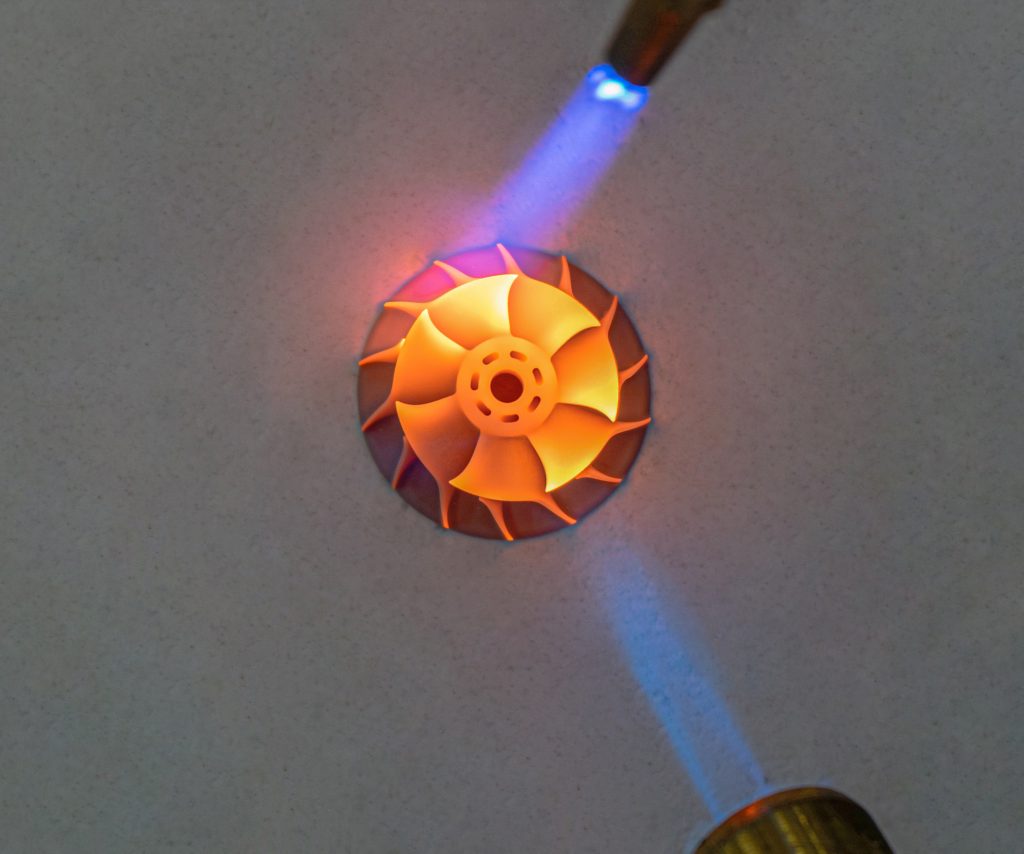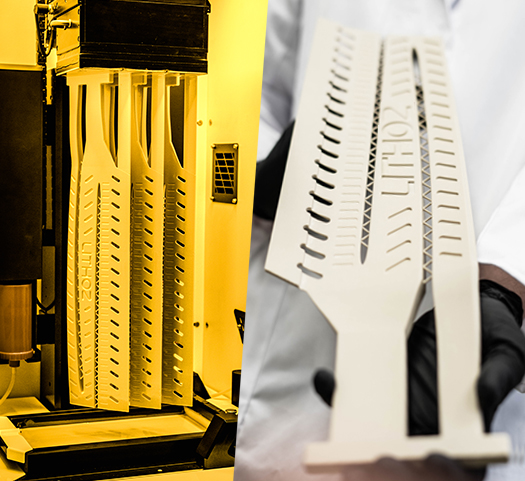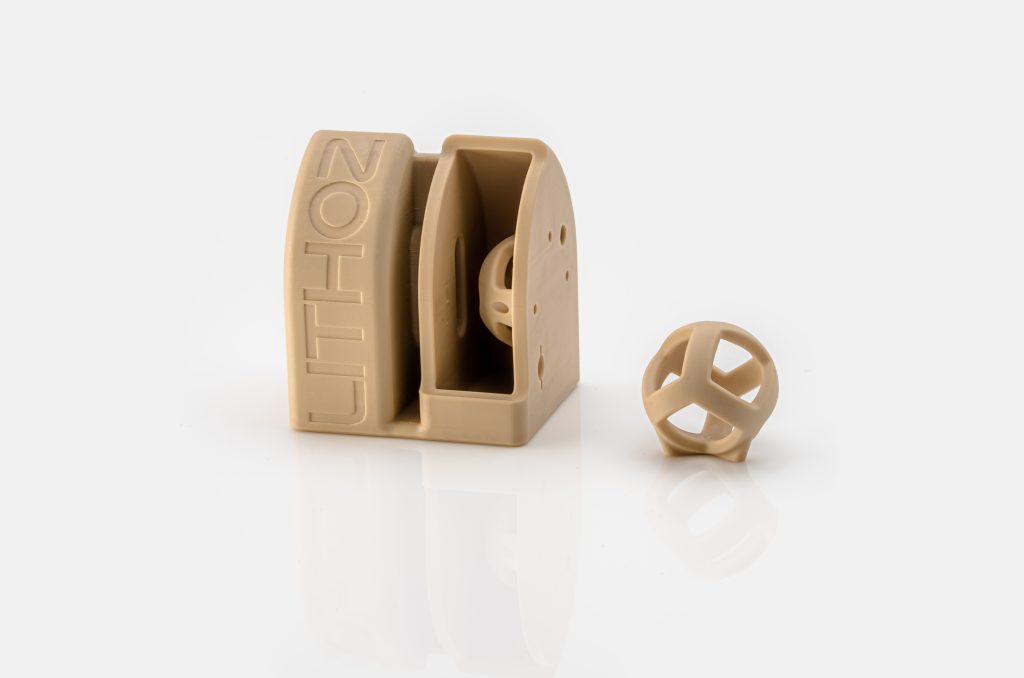When it comes to 3D printing in aerospace, metals are often the conventional material. However, high-performance 3D printed ceramics possess a number of excellent properties which make them highly efficient, and especially well suited for use in extreme environments. This makes ceramics ideal for 3D printing parts for aerospace applications.
In this article, we explore the significant potential offered by ceramics, and how Lithoz’s LCM technology is changing the game for 3D printing and aerospace.
The impressive properties of ceramics
Currently, the widespread use of metals means that ceramics are rarely at the top of an engineer’s shopping list. However, the fact that metals quickly reach their natural limits under harsh conditions means that ceramics are gaining ever more prominence.
But what makes ceramics so well suited to harsh and extremely demanding environments?
High-performance ceramics possess incredibly high hardness, abrasion and heat resistance, and are resistant to hot corrosion and oxidation. Additionally, parts 3D printed with ceramic offer mechanical and dimensional stability, whilst maintaining mechanical strength at incredibly high temperatures. Ceramics also have an electrical and thermal insulation effect, adding to their utility for internal mechanical components.
Combine those excellent properties with the design flexibility of 3D printing, and you will explore a completely new dimension of aerospace applications.
3D printing ceramics for aerospace applications
It is widely known that additive manufacturing can produce parts that are more durable and complex than anything currently possible through conventional manufacturing methods. Moreover, when manufacturing components for space and aviation applications, it is vital that the chosen material will withstand even the most extreme thermal conditions. Therefore, 3D printing with ceramics offers the perfect combination for producing parts that are both highly complex and therefore more efficient, capable of performing in harsh and demanding environments.
Indeed, engineers are always searching for ways to increase efficiency, reduce consumption, limit waste, improve cooling, and achieve longer uptime. Combining the design freedom of 3D printing with the durability of ceramics offers the ideal solution for this.
One key benefit offered by this combination is the reduction of space debris. Thanks to their durability, ceramic parts can be used where even the toughest metals fail. Within an aerospace context, metals possess a shorter lifespan than ceramics, and will fail faster when exposed to extreme thermal conditions. These failed parts become space debris. Using ceramics reduces space debris as stressed parts show less wear under these extreme conditions.
Additionally, 3D printing with ceramics allows for the production of highly precise and intricate parts. Within spacecraft, parts ranging from thrusters and sensors, to complex aviation casting cores with intricate channels, require an incredible high level of precision and accuracy.
Within aviation, stricter emission regulations require ever more complex cooling channels in turbine blades to achieve better efficiency by more refined cooling. The traditional investment casting method is not able to produce such fine structures. 3D printed ceramic casting cores allow for much better design freedom, higher part complexity and ultimately the desired improved cooling effect.

Lithoz and ceramic 3D printing
Lithoz, a leading developer of industrial ceramic 3D printers, has already successfully accessed the potential offered by ceramic 3D printing for aerospace applications. Lithoz’s CeraFab S65 industrial printer with Lithography-based Ceramic Manufacturing (LCM) technology offers ultra precise 3D printing with exact repeatability in serial production.
One highly in-demand quality of Lithoz’s LCM technology is the ability to 3D print ceramic casting cores for aircraft turbine blades. As already mentioned, 3D printed ceramic casting cores are crucial for producing complex turbine blade cooling channels. The speed and volume at which Lithoz’s 3D printers can produce these parts drastically reduces development time, speeding up time-to-market.

Ideal for manufacturing complex and precise ceramic parts, Lithoz’s CeraFab Multi 2M30 LCM 3D printer also offers multi-material capabilities. This 3D printer can combine different ceramics with metals or polymers, allowing for groundbreaking multi-functional parts with a combination of many desirable material properties in a single part. Lithoz’s new two-vat system allows these different materials mixed layer by layer or even flexibly graded in the same layer during the same print job.
For instance, this two-vat system allows for tailored porosity to be achieved. Lithoz’s multi-material LCM 3D printers can overcome the main problems of conventional manufacturing techniques for fabrication of porosity graded alumina, with desired microstructure and gradient architecture. This is ideal for R&D applications for ion thrusters.
Lithoz’s LCM process combines the desired aerospace properties with the otherwise unachievable flexibility of 3D-printed designs. This results in the production of fully dense parts with unmatched detail and precision.
As a result, parts can be 3D printed that are stronger and possess a longer lifespan than metal, resulting in less space debris and less downtime. What’s more, these ceramic components can also incorporate complex designs previously unthinkable when using conventional production methods.
Lithoz have also scaled up their technology to the level of industrial serial production. Therefore, in addition to the technical and material advantages offered by LCM, production can be ramped up to serial level for 3D printing high-quality parts at volume.
One perfect example of how LCM ceramic 3D printing will change the level of efficiency in aerospace applications are ceramic RF filters. Such filters are electronic circuits which play a crucial role in enhancing signal quality and minimizing interference in communication systems. Ceramic 3D printing with LCM technology allows for the necessary complex and precise shapes of these filters to be systematically produced in a miniaturized format. This shrinkage of the entire application allows for a significant weight reduction, the number one objective of aerospace engineers.

A key benefit of using ceramics with a high dielectric constant and low loss factor is the fact that the higher the dielectric constant (at a stable loss factor) is, the smaller the filter can be designed. Therefore, these ceramics are ideal for LCM technology that offers unmatched precision, and which is optimized for 3D printing miniaturized parts.
Silicon nitride aerospike nozzles can also be 3D printed with Lithoz LCM technology, with Lithoz’s LithaNit material ideal for such applications. Due to their high strength, alkali and acid resistance, and especially its superior thermal shock resistance, these dark ceramics are perfect for aerospace components. Silicon nitride is ideal for 3D printing insulators, springs and turbine wheels.
Subscribe to the 3D Printing Industry newsletter to ensure you keep up with the latest 3D printing news. You can also follow us on Twitter, like our Facebook page, and subscribe to the 3D Printing Industry Youtube channel to access more exclusive content.
Are you interested in working in the additive manufacturing industry? Visit 3D Printing Jobs to view a selection of available roles and kickstart your career.
Featured image shows a fired silicon nitride nozzle. Photo via Lithoz.


